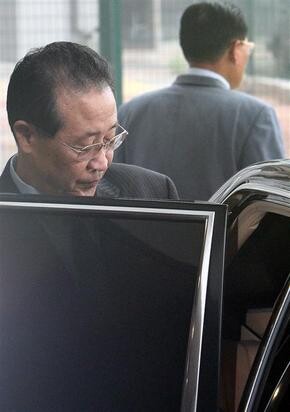hankyoreh
Links to other country sites 다른 나라 사이트 링크
Could Hill’s Beijing trip turn the tide of the six-party talks?

With North Korea showing signs of restoring its nuclear facility at Yongbyon, the parties of the six-party talks, including South Korea, the United States and China, are also getting busy.
Convening a press conference for local and foreign reporters at the Foreign Ministry headquarters in Seoul’s Doryeom-dong on September 4, Foreign Minister Yu Myung-hwan said the North Koreans have informed U.S. technical personnel and inspectors from the International Atomic Energy Agency at Yongbyon that it has decided to restore the facility. He called North Korea’s measure unilateral and asked that Pyongyang sincerely deal with the verification negotiations currently underway.
U.S. Assistant Secretary of State Christopher Hill left for Beijing on September 4 to hold bilateral talks with other six-party delegation heads, including Chinese Vice Foreign Minister Wu Dawei and South Korean chief negotiator Kim Sook. A high-ranking South Korean government official said no meeting between the United States and North Korean negotiators or North and South Korean negotiators are planned or being pushed. Nevertheless, the North has reportedly been informed of Hill’s trip to Beijing through diplomatic channels.
Whether Hill meets with North Korean chief negotiator Kim Kye-gwan is predicted to be the watershed that will determine the course of the six-party talks. If North Korea and the United States hold bilateral talks, progress could be seen in the negotiations for a verification agreement on North Korea’s declared nuclear activities. If Kim does not come to Beijing and North Korea-U.S. bilateral talks cannot be held, it is possible that North Korea will gradually increase the level of activity at Yongbyon required to restart the facility. Experts say that the latter is currently the more likely.
South Korea and the United States have reportedly decided to work on persuading the North to reverse course and will stress the need for a verification agreement to be concluded as soon as possible. They also agreed to continue economic and energy aid. U.S. Secretary of State Condoleezza Rice has repeatedly stressed that she expects North Korea to live up to its obligations, and that the United States has obligations it must keep, too.
Foreign Minister Yu and other high-ranking government officials said that since September 3, North Korea has moved to the reactor the reactor equipment it had removed from the facility and placed in storage during the process of disabling the plant. It has also started clearing up the debris from the area around the former cooling tower, which was demolished in June.
A subtle difference in understanding concerning North Korea’s actions has appeared between Seoul and Washington as well. U.S. State Department spokesman Sean McCormack said September 3, “To my knowledge, based on what we know from the reports on the ground, you don’t have an effort to reconstruct, reintegrate this equipment back into the Yongbyon facility.” This means he views North Korea’s moves till now as resembling preparations to restart restoration of the plant, rather than the restoration process itself. Controversy has started due to the slight different in nuance expressed by the South Korean side, which announced on the night of September 3 that it has determined that North Korea had started restoring the facility. One diplomatic source said the difference reflects the differing vantage points on the current situation of the U.S. administration of George W. Bush, which is trying to produce results late in its term, and the Lee Myung-bak administration, which is maintaining a hard line.
Please direct questions or comments to [englishhani@hani.co.kr]
Editorial・opinion
![[Column] Season 2 of special prosecutor probe may be coming to Korea soon [Column] Season 2 of special prosecutor probe may be coming to Korea soon](https://flexible.img.hani.co.kr/flexible/normal/500/300/imgdb/original/2024/0426/3317141030699447.jpg) [Column] Season 2 of special prosecutor probe may be coming to Korea soon
[Column] Season 2 of special prosecutor probe may be coming to Korea soon![[Column] Park Geun-hye déjà vu in Yoon Suk-yeol [Column] Park Geun-hye déjà vu in Yoon Suk-yeol](https://flexible.img.hani.co.kr/flexible/normal/500/300/imgdb/original/2024/0424/651713945113788.jpg) [Column] Park Geun-hye déjà vu in Yoon Suk-yeol
[Column] Park Geun-hye déjà vu in Yoon Suk-yeol- [Editorial] New weight of N. Korea’s nuclear threats makes dialogue all the more urgent
- [Guest essay] The real reason Korea’s new right wants to dub Rhee a founding father
- [Column] ‘Choson’: Is it time we start referring to N. Korea in its own terms?
- [Editorial] Japan’s rewriting of history with Korea has gone too far
- [Column] The president’s questionable capacity for dialogue
- [Column] Are chaebol firms just pizza pies for families to divvy up as they please?
- [Column] Has Korea, too, crossed the Rubicon on China?
- [Correspondent’s column] In Japan’s alliance with US, echoes of its past alliances with UK
Most viewed articles
- 1‘We must say no’: Seoul defense chief on Korean, USFK involvement in hypothetical Taiwan crisis
- 2[Column] Season 2 of special prosecutor probe may be coming to Korea soon
- 3N. Korean delegation’s trip to Iran shows how Pyongyang is leveraging ties with Moscow
- 4Amnesty notes ‘erosion’ of freedom of expression in Korea in annual human rights report
- 5[Reportage] On US campuses, student risk arrest as they call for divestment from Israel
- 6Korea sees more deaths than births for 52nd consecutive month in February
- 7[Editorial] New weight of N. Korea’s nuclear threats makes dialogue all the more urgent
- 8‘Weddingflation’ breaks the bank for Korean couples-to-be
- 9[Column] Has Korea, too, crossed the Rubicon on China?
- 10[Column] Park Geun-hye déjà vu in Yoon Suk-yeol